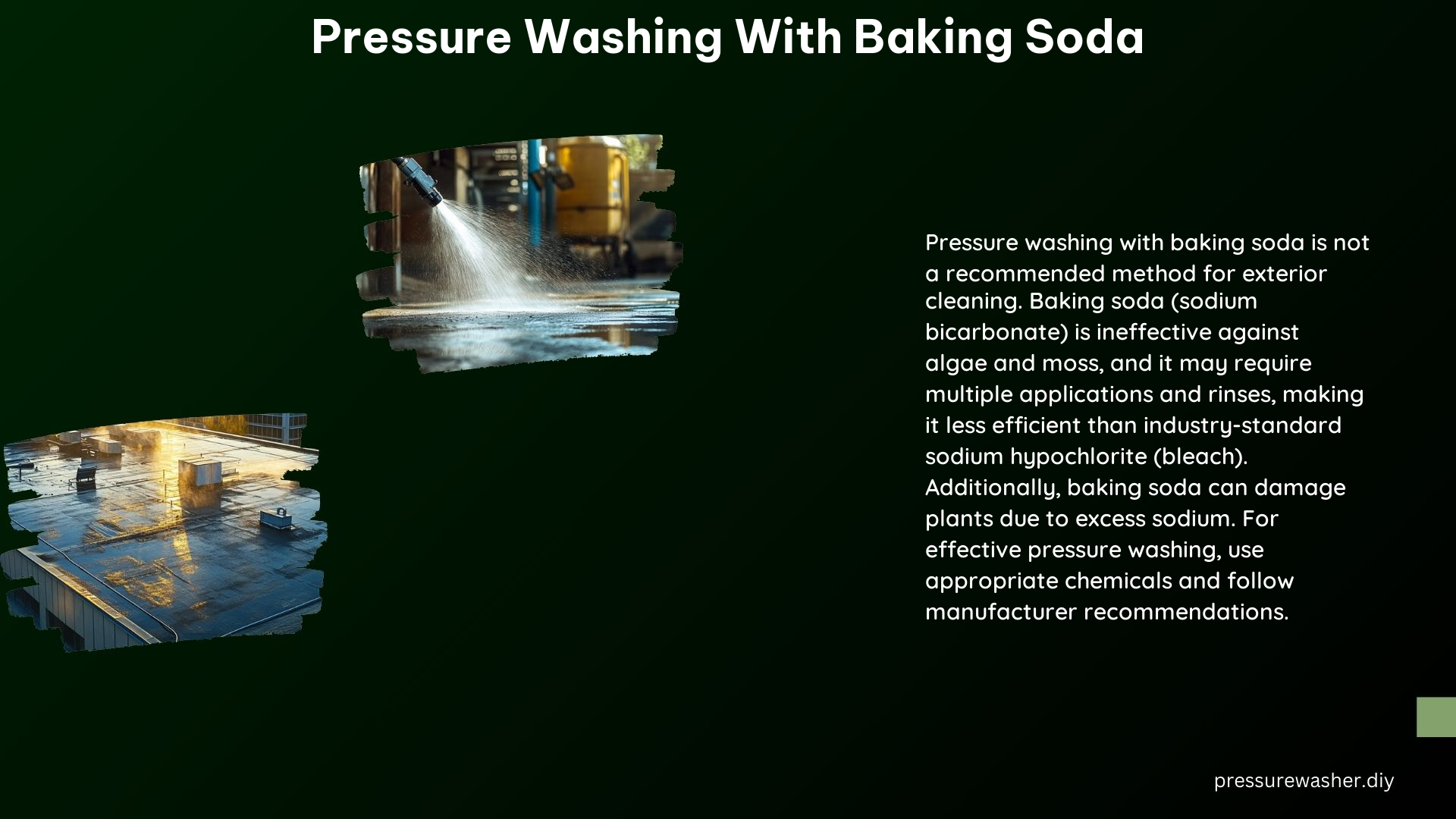Pressure washing with baking soda is a cost-effective and eco-friendly method for cleaning various outdoor surfaces, from driveways and patios to siding and decks. This comprehensive guide will provide you with the technical specifications, step-by-step instructions, and expert tips to help you achieve professional-grade results using this versatile cleaning agent.
Can Baking Soda Be Used as a Cleaning Solution for Pressure Washing?
Absolutely! Baking soda, also known as sodium bicarbonate, is a mild and non-toxic substance that can effectively remove dirt, grime, and stains from a wide range of surfaces. While it may not be as potent as commercial pressure washing solutions containing sodium hypochlorite (bleach), baking soda offers several advantages:
- Eco-Friendly: Baking soda is a natural, biodegradable substance that is safe for the environment and does not release harmful chemicals into the air or water.
- Gentle on Surfaces: Baking soda is a relatively soft abrasive, making it suitable for cleaning delicate materials like wood, vinyl, and painted surfaces without causing damage.
- Versatile: Baking soda can be used on a variety of surfaces, including concrete, brick, stone, and metal, making it a versatile cleaning agent for pressure washing.
How Effective Is Baking Soda in Removing Dirt and Stains During Pressure Washing?

Baking soda’s effectiveness in removing dirt and stains during pressure washing can vary depending on the severity of the buildup and the specific surface being cleaned. Generally, baking soda is most effective at:
- Removing Organic Stains: Baking soda is particularly effective at breaking down and removing organic stains, such as those caused by mold, mildew, or algae.
- Deodorizing Surfaces: The alkaline nature of baking soda helps neutralize and eliminate odors, making it useful for cleaning surfaces that have absorbed unpleasant smells.
- Lifting Grease and Oil Stains: Baking soda’s mild abrasive properties can help lift and remove stubborn grease and oil stains, often found on driveways, garage floors, and other high-traffic areas.
However, for heavily soiled or deeply ingrained stains, baking soda may require multiple applications and longer dwell times to achieve the desired results. In such cases, it may be necessary to combine baking soda with other cleaning agents, such as vinegar or a mild detergent, to enhance its cleaning power.
What Is the Recommended Ratio of Baking Soda to Water for Pressure Washing?
The recommended ratio of baking soda to water for pressure washing can vary depending on the specific application and the level of dirt or staining on the surface. As a general guideline, a good starting point is to mix:
- Light Cleaning: 1 cup of baking soda per 1 gallon of water
- Medium Cleaning: 1.5 cups of baking soda per 1 gallon of water
- Heavy Cleaning: 2 cups of baking soda per 1 gallon of water
It’s important to note that these ratios are just starting points, and you may need to adjust the mixture based on the results you observe during the pressure washing process. If the solution appears too weak, you can increase the baking soda concentration; if it seems too abrasive, you can dilute it further with water.
Technical Specifications of Pressure Washing With Baking Soda
When pressure washing with baking soda, it’s essential to consider the following technical specifications to ensure optimal results and minimize the risk of damage to the surface:
Pressure Washer Settings
The pressure setting for your pressure washer should be adjusted based on the surface being cleaned:
| Surface | Pressure Range (psi) |
|---|---|
| Soft Woods (e.g., cedar, pine) | 500 – 600 |
| Harder Woods (e.g., oak, maple) | 800 – 1000 |
| Concrete | 1000 – 2000 |
| Brick | 800 – 1200 |
| Vinyl Siding | 500 – 800 |
Nozzle Distance
The distance between the pressure washer nozzle and the surface being cleaned should be maintained at 2-3 feet. This distance helps ensure effective cleaning while minimizing the risk of damage to the surface.
Dwell Time
The baking soda solution should be allowed to dwell on the surface for 15-30 minutes before rinsing. This dwell time allows the baking soda to penetrate and break down the dirt and stains, enhancing the cleaning effectiveness.
DIY Tips and Precautions
When using baking soda for pressure washing, it’s essential to follow these tips and precautions to ensure a successful and safe cleaning process:
- Test a Small Area First: Always test the baking soda solution on a small, inconspicuous area of the surface to ensure it does not cause any damage or discoloration.
- Use Protective Gear: Wear appropriate personal protective equipment, such as gloves, safety glasses, and a mask, to protect yourself from the pressure washing process and any potential splashing.
- Avoid Using Baking Soda on Plants: Baking soda can be harmful to plants, so it’s crucial to avoid using it near vegetation or to take precautions to protect any plants in the surrounding area.
- Rinse Thoroughly: Make sure to thoroughly rinse the surface after pressure washing with baking soda to remove any residual solution and prevent it from causing damage over time.
- Adjust Mixture as Needed: Monitor the cleaning process and adjust the baking soda-to-water ratio as needed to achieve the desired results without over-scrubbing the surface.
By following these technical specifications and DIY tips, you can effectively and safely use baking soda for pressure washing, achieving professional-grade results while maintaining the integrity of your outdoor surfaces.
References
- https://www.reddit.com/r/pressurewashing/comments/vcyr3d/can_i_use_sodium_bicarbonate/
- https://www.homes.com/blog/things-you-should-know-before-you-power-wash-anything/
- https://www.youtube.com/watch?v=LjZfbxkTM9g
- https://www.garagejournal.com/forum/threads/wet-soda-blasting-using-pressure-washer-attachement.439629/
- https://www.countryliving.com/home-maintenance/cleaning/a29562464/how-to-use-pressure-washing/
